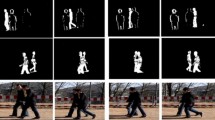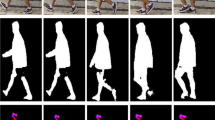Abstract
Gait recognition is a challenging problem in computer vision, especially when multi-persons walk together, called as multi-gait recognition. Multi-gait recognition includes two aspects: participant segmentation and participant recognition. In this paper, we propose to segment each participant by hypergraph partition and recognize each participant by multi-linear canonical correlation analysis algorithm (UMCCA). Firstly, raw pixel areas are obtained by grid, and each pixel area is taken as a hypergraph vertex. Then HOG-based detection and tracking technology is used to calculate the weight of each hyperedge. After segmentation, UMCCA is used to extract gait features. Finally, identity of multi-gait is recognized. The experimental results demonstrate that our proposed method achieves good performance on multi-gait dataset.






Similar content being viewed by others
References
Choudhury, S.D., Tjahjadi, T.: Gait recognition based on shape and motion analysis of silhouette contours. Comput. Vis. Image Underst. 117, 1770–1785 (2013)
Weng, W.G., Chen, T., Yuan, H.Y.: Cellular automaton simulation of pedestrian counter flow with different walk velocities. Phys. Rev. E 74, 036102_1–.036102_7 (2006)
Kirchner, A., Klupfel, H., Nishinari, K., Schadschneider, A., Schreckenberg, M.: Simulation of competitive egress behavior comparison with aircraft evacuation data. Phys. A 324, 689–697 (2003)
Huo, F., Song, W., Lv, W., Liew, K.M.: Analyzing pedestrian merging flow on a floorstair interface using an extended lattice gas model. Commun. Theor. Phys. 90(5), 501–510 (2014)
Wang, Z., Song, B., Qin, Y., Jia, L.: Team-moving effect in bi-direction pedestrian flow. Phys. A 391, 3119–3128 (2012)
Brooks, G., Krishnamurthy, P., Khorrami, F.: A multi-gait approach for humanoid navigation in cluttered environments. In: Proceedings of CCDC (2014)
Guan, R., Liu, J., Liu, J.: Fusion algorithm for multi-gait of hexapod bionic rescue robot. Adv. Mater. Res. 433–440, 3033–3037 (2012)
Reis, M., Yu, X., Maheshwari, N., Iida, F.: Morphological computation of multi-gaited robot locomotion based on free vibration. Artif. Life 19(1), 97–114 (2013)
Guldogan, M.B., Lindgren, D., Gustafsson, F., Habberstad, H., Orguner, U.: Multi-target tracking with PHD filter using Doppler-only measurements. Digit. Signal Process. 27, 1–11 (2014)
Kim, S., Kwak, S., Feyereisl, J., Han, B.: Online multi-target tracking by large margin structured learning. In: ACCV (2012)
Macqueen, J.B.: Some methods of classification and analysis of multivariate observations. In: Proceedings of Fifth Berkeley Symposium on Mathematical Statistics and Probability, pp. 281–297 (1967)
Wu, B., Nevatia, R.: Detection and tracking of multiple partially occluded humans by bayesian combination of edgelet based part detectors. Int. J. Comput. Vis. 75, 247–266 (2007)
Huang, Y., et al.: Unsupervised image categorization by hypergraph partition. IEEE Trans. Pattern Anal. Mach. Intell. 33(6), 1266–1273 (2011)
Lowe, D.: Distinctive image features from scale-incariant key points. Int. J. Comput. Vis. 60(2), 91–110 (2004)
Bay, H., Tuytelaars, T., Gool, L.V.: SURF: speeded up robust features. In: Proceedings of ECCV (2006)
Yu, J., Rui, Y., Tao, D.: Click prediction for web image reranking using multimodal sparse coding. IEEE Trans. Image Process. 23(5), 2019–2031 (2014)
Su, J., Dong, L., Ren, P., Hancock, E.R.: Hypergraph matching based on marginalized constrained compatibility. In: Proceedings of ICPR (2013)
Zass, R., Shashua, A.: Probabilistic graph and hypergraph matching. In: Proceedings of CVPR (2008)
Roy, A., Sural, S., Mukherje, J.: Gait recognition using pose kinematics and pose energy image. Signal Process. 92(3), 780–792 (2012)
Jeong, S., Cho, J.: A framework for online gait recognition based on multilinear tensor analysis. J. Supercomput. 65, 106–121 (2013)
Lu, H., Plataniotis, K.N., Venetsanopoulos, A.N.: MPCA: Multilinear principal component analysis of tensor objects. IEEE Trans. Neural Netw. 19(1), 18–39 (2008)
Tao, D., Li, X., Wu, X., Maybank, S.J.: General tensor discriminant analysis and gabor features for gait recognition. IEEE Trans. Pattern Anal. Mach. Intell. 29(10), 1700–1714 (2007)
Hu, H.: Multiview gait recognition based on patch distribution features and uncorrelated multilinear sparse local discriminant canonical correlation analysis. IEEE Trans. Circuits Syst. Video Technol. 24(4), 617–630 (2014)
Liu, S., Zhang, Y., Liu, K., Li, Y.: Facial expression recognition under partial occlusion based on gabor multi-orientation features fusion and local gabor binary pattern histogram sequence. In: Proceedings of Ninth International Conference on Intelligent Information Hiding and Multimedia Signal Processing (2013)
Hu, H.: Enhanced gabor feature based classification using a regularized locally tensor discriminant model for multiview gait recognition. IEEE Trans. Circuits Syst. Video Technol. 23(7), 1274–1286 (2013)
Chen, C., Liang, J., Zhao, H., Hu, H., Tian, J.: Frame difference energy image for gait recognition with incomplete silhouettes. Pattern Recognit. Lett. 30, 977–984 (2009)
Weinland, D., Ozuysal, M., Fua, P.: Making action recognition robust to occlusions and viewpoint changes. In: ECCV (2010)
Agarwal, S., Branson, K., Belongie, S.: Higher order learning with graphs. In: Proceedings of International Conference on Machine Learning (2006)
Zhou, D., Huang, J., Schokopf, B.: Learning with hypergraphs: clustering, classification, and embedding. In: Proceedings of Conference Advances in Neural Information Processing Systems (2007)
Possegger, H., Mauthner, T., Roth, P.M., Bischof, H.: Occlusion geodesics for online multi-object tracking. In: Proceedings of CVPR (2014)
Fleuret, F., Berclaz, J., Lengagne, R., Fua, P.: Multi-camera people tracking with a probabilistic occupancy map. IEEE Trans. Pattern Anal. Mach. Intell. 30(2), 267–282 (2008)
Dalal, N., Triggs, B., Schmid, C.: Human detection using oriented histograms of flow and appearance. In: Proceedings of European Conference Computer Vision (2006)
Satpathy, A., Jiang, X., Eng, H.L.: Human detection by quadratic classification on subspace of extended histogram of gradients. IEEE Trans. Image Process. 23(1), 287–297 (2014)
Kuhn, H.W.: The Hungarian method for the assignment problem. Naval Res. Logist. Quart. 2, 83–87 (1955)
Gold, S., Rangarajan, A.: Softmax to softassign: neural network algorithms for combinatorial optimization. J. Artif. Neural Netw. 2(4), 381–399 (1995)
Huang, C., Li, Y., Nevatia, R.: Multiple target tracking by learning-based hierarchical association of detection responses. IEEE Trans. Pattern Anal. Mach. Intell. 35(4), 898–910 (2013)
Berclaz, J., Fleuret, F., Tretken, E., Fua, P.: Multiple object tracking using K-shortest paths optimization. IEEE Trans. Pattern Anal. Mach. Intell. 33(9), 1806–1819 (2011)
Jin, Z., Yang, J.Y., Hu, Z.S., Lou, Z.: Face recognition based on the uncorrelated discriminant transformation. Pattern Recognit. 34(7), 14051416 (2001)
Liu, N., Lu, J., Tan, Y.P.: Joint subspace learning for view-invariant gait recognition. IEEE Signal Process. Lett. 18, 431–434 (2011)
Jeong, S., Cho, J.: A framework for online gait recognition based on multilinear tensor analysis. J. Supercomput. 65, 106121 (2013)
Lu, H., et al.: MPCA: multilinear principal component analysis of tensor objects. IEEE Trans. Neural Netw. 19(1), 18–38 (2008)
Lathauwer, L.D., Moor, B.D., Vandewalle, J.: A multilinear singular value decomposition. SIAM J. Matrix Anal. Appl. 21(4), 1253–1278 (2000)
Rodrequez, J.: On the Laplacian spectrum and walk-regular hypergraphs. Linear Multilinear Algebra 51, 285–297 (2003)
Andriluka, M., et al.: People-tracking-by detection and people-detection-by-tracking. In: CVPR (2008)
Breitenstein, M.D., et al.: Online multiperson tracking-by-detection from a single, uncalibrated camera. IEEE Trans. Pattern Anal. Mach. Intell. 33(9), 208–219 (2011)
Shu1, G., et al.: Part-based multiple-person tracking with partial occlusion handling. In: CVPR (2012)
Felzenszwalb, P., Girshick, R., McAllester, D., Ramanan, D.: Object detection with discriminatively trained part-based models. In: PAMI (2010)
Felzenszwalb, P., Girshick, R., McAllester, D.: Cascade object detection with deformable part models. In: CVPR, IEEE (2010)
Pedersoli, M., Vedaldi, A., Gonzalez, J.: A coarse-to-fine approach for fast deformable object detection. In: CVPR, IEEE (2011)
Kokkinos, I.: Rapid deformable object detection using dual-tree branch-and-bound. In: NIPS (2011)
Dubout, C., Fleuret, F.: Exact acceleration of linear object detectors. In: ECCV, Springer (2012)
Yan, J., Lei, Z., Wen, L., Li, S.Z.: The fastest deformable part model for object detection. In: Proceedings of CVPR (2014)
Han, J., Bhanu, B.: Individual recognition using gait energy image. IEEE Trans. Pattern Anal. Mach. Intell. 28(2), 316–322 (2006)
Liu, L.-F., Jia, W., Zhu, Y.-H.: Survey of gait recognition. In: Huang, D.-S., Jo, K.-H., Lee, H.-H., Kang, H.-J., Bevilacqua, V. (eds.) Emerging Intelligent Computing Technology and Applications. With Aspects of Artificial Intelligence. Lecture Notes in Computer Science, vol. 5755, pp, 652–659. Springer, Berlin, Heidelberg (2009)
Liu, J., Musialski, P., Wonka, P., Ye, J.: Tensor completion for estimating missing values in visual data. IEEE Trans. Pattern Anal. Mach. Intell. 35(1), 208–219 (2013)
Author information
Authors and Affiliations
Corresponding author
Rights and permissions
About this article
Cite this article
Chen, X., Xu, J. & Weng, J. Multi-gait recognition using hypergraph partition. Machine Vision and Applications 28, 117–127 (2017). https://doi.org/10.1007/s00138-016-0810-6
Received:
Revised:
Accepted:
Published:
Issue Date:
DOI: https://doi.org/10.1007/s00138-016-0810-6




